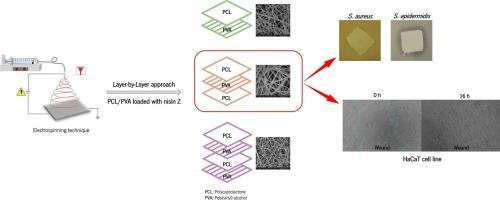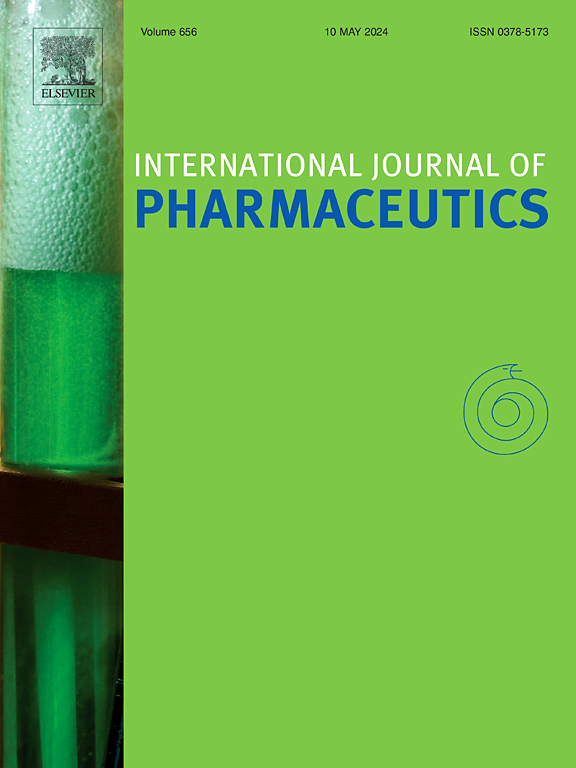一层一层的静电纺PCL/PVA垫装载nisin Z增强糖尿病足溃疡治疗。
IF 5.2
2区 医学
Q1 PHARMACOLOGY & PHARMACY
引用次数: 0
摘要
糖尿病足溃疡(DFUs)由于愈合受损和极易感染,是一个重大的临床挑战,强调了对多功能伤口敷料的迫切需要。本研究以聚己内酯(PCL)和聚乙烯醇(PVA)为材料,利用抗菌肽(AMP) nisin z进行层接层沉积,制备了PCL/PVA、PCL/PVA/PCL和PCL/PVA/PCL/PVA三种结构的多层电纺垫,并对其理化、力学和生物性能进行了表征。抗拉强度为0.9 ~ 2.7 MPa,膨胀度为 2/s。使用HaCaT进行的角化细胞生物相容性试验显示,其具有良好的细胞相容性,代谢活性超过93 %,细胞生长超过87 %,并且在16 h内增强细胞迁移,导致伤口愈合。nisin Z的加入对革兰氏阳性细菌、金黄色葡萄球菌和表皮葡萄球菌具有显著的抗菌活性,在24 h内达到100% %的细菌抑制,并使生物膜的形成减少50% %以上。在测试的垫子中,PCL/PVA/PCL配置显示出最有希望的特性。总的来说,这些发现突出了多层电纺丝垫作为DFUs生物活性伤口敷料的潜力,为改善伤口愈合提供了多作用策略。本文章由计算机程序翻译,如有差异,请以英文原文为准。

Layer-by-layer electrospun PCL/PVA mats loaded with nisin Z for enhanced diabetic foot ulcer treatment
Diabetic foot ulcers (DFUs) represent a significant clinical challenge due to impaired healing and high susceptibility to infections, underscoring the urgent need for multifunctional wound dressings. This study explores the potential of multilayered electrospun mats composed of polycaprolactone (PCL) and poly(vinyl alcohol) (PVA) engineered by a layer-by-layer (LbL) electrospun-based deposition, and functionalized with the antimicrobial peptide (AMP) nisin Z. Three LbL configurations (PCL/PVA, PCL/PVA/PCL, and PCL/PVA/PCL/PVA) were produced and characterized in terms of physicochemical, mechanical and biological performance. The mats exhibited tensile strengths of 0.9–2.7 MPa, swelling degree < 90 % and ≈ 20 % degradation after 7 and 28 days under physiological-like environments, respectively, while maintaining air permeability between 0.5 and 1.3 mL/cm2/s. Biocompatibility assays using HaCaT keratinocytes demonstrated excellent cytocompatibility, with metabolic activity exceeding 93 %, cell growth above 87 %, and enhanced cell migration leading to wound closure within 16 h. The incorporation of nisin Z provided significant antimicrobial activity against Gram-positive bacteria, Staphylococcus aureus and Staphylococcus epidermidis, achieving up to 100 % bacterial inhibition within 24 h, and reducing biofilm formation by more than 50 %. Among the tested mats, the PCL/PVA/PCL configuration revealed the most promising features. Overall, these findings highlight the potential of multilayer electrospun mats as bioactive wound dressings for DFUs, offering a multi-action strategy for improved wound healing.
求助全文
通过发布文献求助,成功后即可免费获取论文全文。
去求助
来源期刊
CiteScore
10.70
自引率
8.60%
发文量
951
审稿时长
72 days
期刊介绍:
The International Journal of Pharmaceutics is the third most cited journal in the "Pharmacy & Pharmacology" category out of 366 journals, being the true home for pharmaceutical scientists concerned with the physical, chemical and biological properties of devices and delivery systems for drugs, vaccines and biologicals, including their design, manufacture and evaluation. This includes evaluation of the properties of drugs, excipients such as surfactants and polymers and novel materials. The journal has special sections on pharmaceutical nanotechnology and personalized medicines, and publishes research papers, reviews, commentaries and letters to the editor as well as special issues.

 求助内容:
求助内容: 应助结果提醒方式:
应助结果提醒方式:


